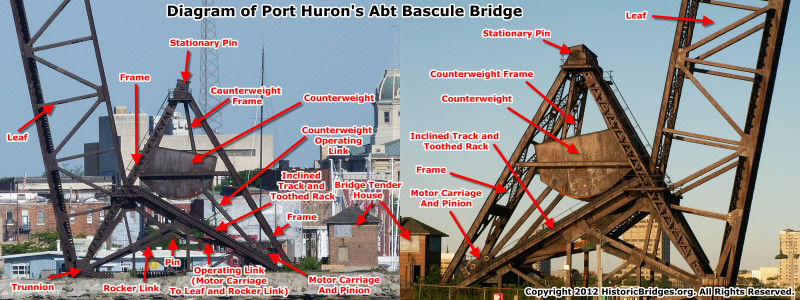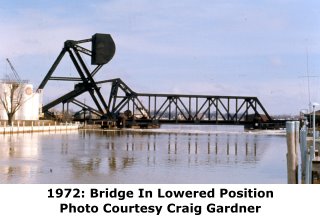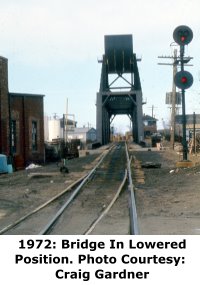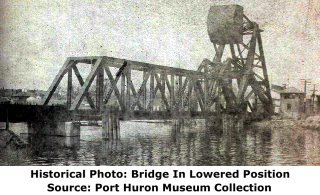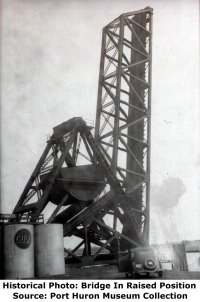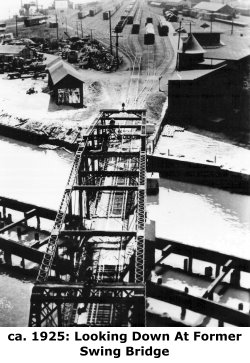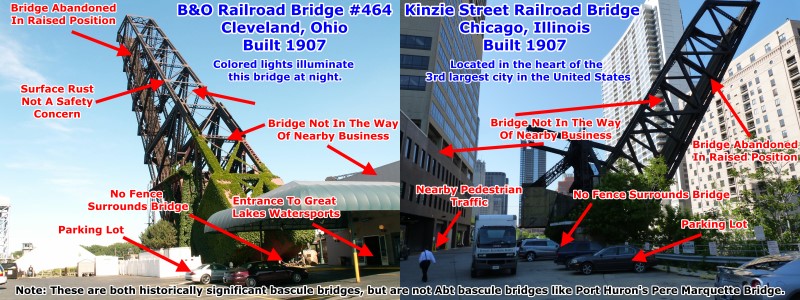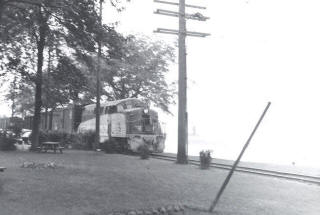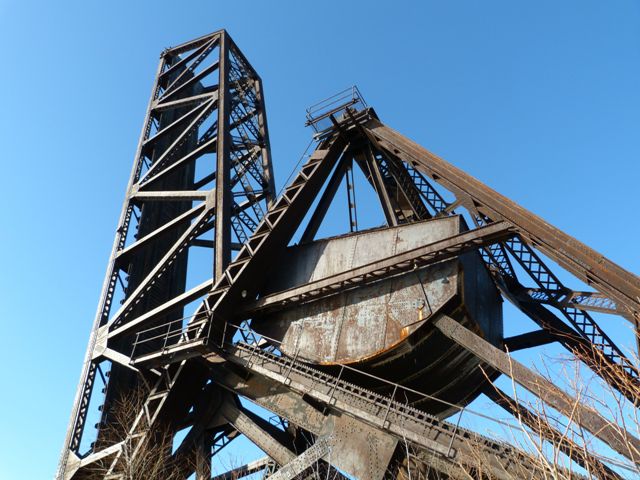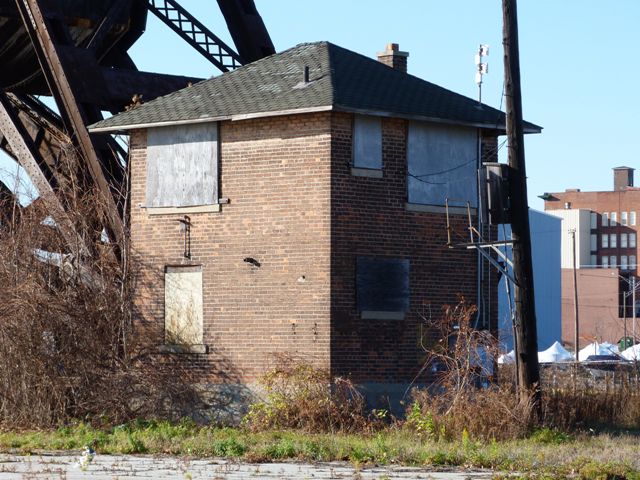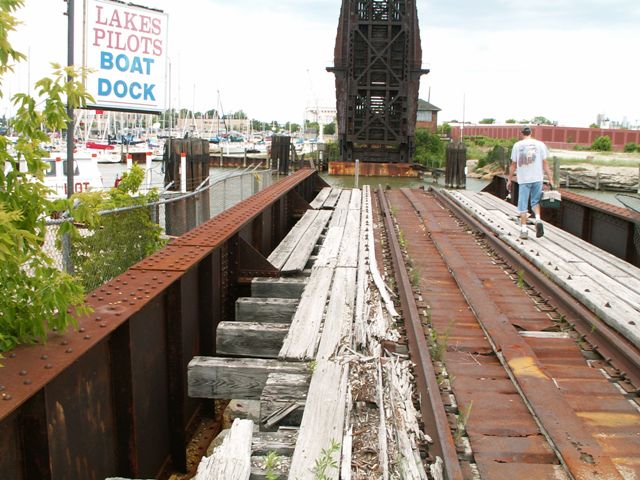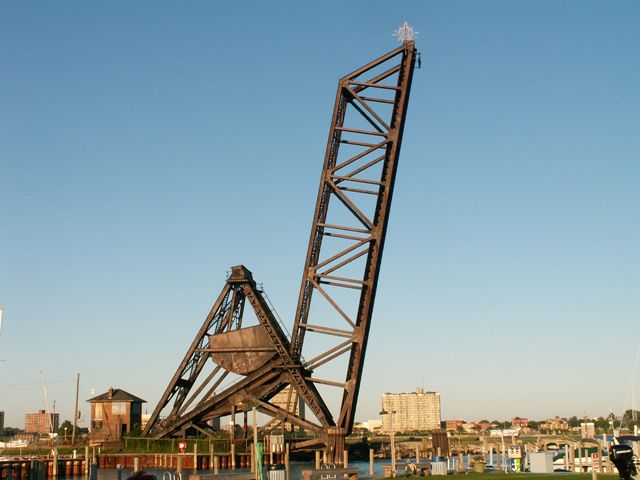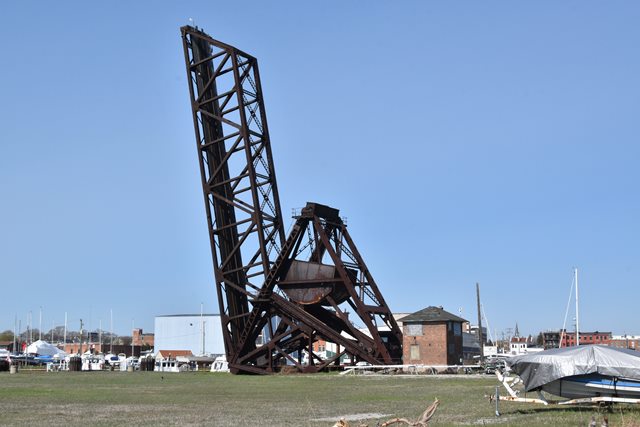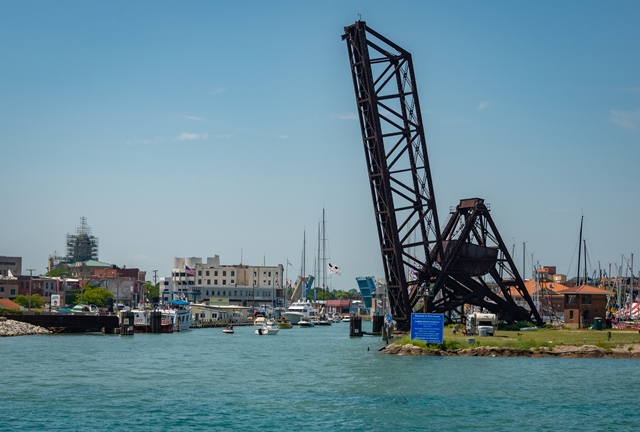We Recommend:
Bach Steel - Experts at historic truss bridge restoration.
Port Huron Railroad Bridge
Pere Marquette Railroad Bridge

Primary Photographer(s): Nathan Holth
Bridge Documented: July 1, 2006 - February 7, 2022
Railroad (Abandoned CSX) (Former Pere Marquette) Over Black River
Port Huron: St. Clair County, Michigan: United States
Metal 8 Panel Rivet-Connected Warren Through Truss, Movable: Single Leaf Bascule (Abt) and Approach Spans: Metal Through Girder, Fixed
1931 By Builder/Contractor: American Bridge Company of New York, New York
Not Available or Not Applicable
173.0 Feet (52.7 Meters)
234.0 Feet (71.3 Meters)
18 Feet (5.49 Meters)
1 Main Span(s) and 1 Approach Span(s)
Not Applicable

View Information About HSR Ratings
Bridge Documentation
This bridge no longer exists!
Bridge Status: This nationally significant bridge and famous city landmark was demolished April 2023 under the sole direction and support of the Port Huron Yacht Club, with the bridge project under the direction of past Commodore Dale Conger.This bridge's song is: Staind - Failing:
Detailed Bridge Narrative:
View Historical Articles About This Bridge
Visit The Friends of the Pere Marquette Railroad Bridge Facebook Page
A Brief Word About The Legacy of Dale Conger and the Port Huron Yacht Club
You would think that an organization like a yacht club would be one that would exist in harmony with and in support of the community in which it exists. Yet nothing could be further from the truth with the Port Huron Yacht Club. This is a parasitic organization that leeches off Port Huron's charm at the unique location where Lake Huron meets the St. Clair River and in return does nothing other than remove one of the most iconic and defining elements of the Port Huron skyline. They are also an impotent organization, to the point which they actually have nothing whatsoever to do with the "Port Huron to Mackinac Yacht Race," that famed event actually being run by a yacht club out of Detroit. And speaking of Detroit, so great was the Port Huron Yacht Club's disdain and hatred for the Port Huron Railroad Bridge that they sought to spend god knows how much money to hire a big city lawyer out of Detroit to defend their decision to wipe this Port Huron landmark off the face of the earth. They are a poor organization, that barely was able to scrape up enough money to destroy this bridge, a decision which defies logic since if your organization has so little money why waste it destroying this bridge that was not interfering with any of your organization's operations? The reason however is clear: spite. In the end it is clear they wanted to demolish this bridge out of spite, to the point that Dale Conger continued to pursue this outcome long after his time as commodore of the yacht club had expired.
So the author of HistoricBridges.org is happy to give Dale Conger and the Port Huron Yacht Club, EXACTLY what they wanted... that which they fought for a decade to make a reality. To be known as the destroyers. And here it is, the statement they longed for so badly. Dale Conger and the Port Huron Yacht Club are the destroyers of the Port Huron Railroad Bridge. And may nobody forget it in the years to come when people ask why such a unique landmark was not saved. For this is their legacy forever that can never be undone.
Introduction
This bridge is an extremely rare and significant example of a Abt Bascule bridge, also sometimes referred to as an American Bridge bascule. The design was invented and patented by Hugo A. F. Abt who worked for the American Bridge Company. View The Original American Patent For The Abt Type Bascule Bridge Or View The Canadian Patent. The name Abt bascule comes from Hugo Abt's name, although some sources also turn Abt into an acronym, American Bridge Type, ABT. It is an extremely unusual and fascinating type of trunnion bascule bridge. The design is described in detail by Hugo A.F. Abt in 1921 in his original patent, which are on file in both the United States and Canada. The Port Huron Railroad Bridge appears to very closely follow the patented design, and it contains all the essential details claimed in the patent. There appear to have only been eight Abt bascule bridges ever built, and today only six remain nationwide including Port Huron's bridge. Little has been found about the details of Hugo A. F. Abt's life. He did hold a couple additional bascule bridge patents. View A Second Bascule Design Patent By Hugo Abt and a Third Bascule Design Patent.
Credit is due to the Port Huron in Pictures & Collections from the archives of the Port Huron Museum website for the three historical photos of the bridge which appear in this narrative. This website offered the images as scans of extremely faded negatives that were so faded the bridge was barely discernable. HistoricBridges.org was able to greatly improve the contrast in the photos using modern photo editing software, and is offering the improved images on this page.
Overview of Abt Bascule Bridges
The Abt bascule bridge type is variety of trunnion bascule that is distinguished by the unusual and unique operation of the counterweight and also by the unusual motor carriage which drives the bridge. Unlike many bascule bridges which have a counterweight that is rigidly attached to the bascule leaf, Abt bascules are a type where the counterweight is connected by links and pins. This allows for the unusual operation where the bascule leaf and counterweight rotate in opposite directions.
Unlike Chicago-type fixed trunnion bascule bridges, the rack and pinion do not function with a fixed rotating pinion causing a rack directly attached to the leaf to move. Instead, the rotating pinion moves along a fixed rack on the stationary frame, engaging the various operating links that move the counterweight and bascule leaf. To facilitate this unusual operation, the two electric motors and the pinion shaft are all mounted on a "motor carriage" that moves along with the pinion during bridge operation.
This complex design had several advantages. It separated the weight of the counterweight and the bascule leaf so that the bridge weight was not focused on a single pier or abutment. It also spread out the weight among the superstructure, allowing for lighter dimension structural members. The design also eased the process of constructing the bridge on an active railroad line because the counterweight does not lower down to the deck level when the leaf is raised, and instead leaves sufficient clearance for allow a train under the bridge when the bridge is raised. This design made it possible to build an Abt bascule bridge on the existing alignment of a former single leaf bascule bridge being replaced. The bridge would be constructed on the opposite side of the river as the existing bascule bridge, and it would be constructed in the raised position. Then, trains could still cross the old bridge when the new bridge was raised, by driving under the counterweight. and through the construction, which would all have been occurring overhead and out of the way. This technique would also work if the bridge being replaced was a swing bridge, as was the case with the Port Huron Railroad Bridge. Contrast this with a bascule bridge with overhead counterweights that are rigidly connected to the bascule leaf, and it is clear that when the bridge is raised, the roadway is completely blocked. The Lakeshore Road Bridge over Welland Canal is a good example. A final advantage to the Abt bascule design was the "basket" style of the counterweight. With the design, the basket is created from riveted steel plate, forming a bucket-like shape. When constructed in the raised position, the open face of the basket faces upward, making it possible to easily pour concrete into the basket during construction.
Abt Bascule Bridge Bibliography: Movable Bridge Engineering, 2003
Details and Description of the Port Huron Railroad Bridge
The Port Huron Railroad Bridge's operating mechanics so closely conform to the design described in the Abt patent, that further description beyond that presented in the previous portion of this narrative would be redundant. It is this close conformity which makes the bridge significant as an excellent example of a patented bridge design. However, the bridge itself requires additional description. The Port Huron Railroad Bridge features a bascule leaf that is a traditionally composed Warren through truss. It has riveted connections, and built-up beams with attractive v-lacing and lattice. The tracks are still on the bridge, and the operator building is still standing, albeit with all the windows and doors boarded up. A small through plate girder span provides an approach for the bridge on the south side of the river, opposite the movable span. Placed on this approach span is a small plaque for this big bridge. It credits the American Bridge Company with building the bridge in 1931. This railroad line was originally a Pere Marquette bridge, then it became C & O who later became CSX, who eventually abandoned the railroad right-of-way and the bridge itself as well.
Although the bridge is today abandoned in the raised position, and the majority of the paint on the bridge has failed, the bridge's steel superstructure does not appear to suffer from any advanced deterioration. The rust seen on the bridge appears to be surface rust, meaning that section loss (caused by rust actually eating away at the steel, making it thinner and thus weaker) is not present on the bridge. Additionally, pack rust (caused by rust that forms between two steel plates, bending and spreading the plates apart and weakening them) also does not appear to be present on the bridge in any significant quantity. Fixed in its raised position, it is easy for the air to get at the bridge, keeping moisture from building up on the bridge and causing deterioration of the steel. Additionally, the bridge is not subjected to winter deicing salts, a major cause of steel deterioration on highway bridges (and the vehicles that travel on them).
Historic and Technological Significance
Apparently very few examples of the Abt bascule bridge type were ever constructed. John A. Schultz Jr. of Hazelet and Erdal Inc. commented in a 1994 presentation at the 5th Biennial Symposium at Heavy Movable Structures Inc. that there were only eight Abt bascule bridges built. HistoricBridges.org worked with the website www.bridgehunter.com to compile a list of all eight bridges, which is available here. Michigan however is lucky enough to have three examples. The other two Abt Bascule bridges in Michigan include the Saginaw Bascule Bridge and the Rouge River Railroad Bridge. Click here to view Historical Articles About The River Rouge Bascule Bridge.All three of Michigan's Abt bascule bridges feature a through truss bascule leaf. Outside of Michigan, a single example existed in Manitowoc Wisconsin, with a plate girder superstructure. This bridge was demolished in 2011. In Beaumont, Texas, a very large 230 foot through truss bascule existed until 1969 when it was demolished. San Joaquin County, California also has three small plate girder Abt bascule bridges. This yields a total of only six Abt bascule bridges in the entire country remaining. As such, this bascule type appears to be exceedingly rare.
Nearly all bascule bridges in existence are either fixed trunnion (Chicago type), Scherzer Rolling Lift, or Strauss Heel-Trunnion. From the late 1800s into the first few decades of the 20th Century, a wide variety of very unusual and creative bascule designs were patented by several different engineers, and a few of those patented designs actually became more than a patent and were actually built, albeit in small numbers. Abt bascule bridges are one such example. Because it is unusual to find any type of bascule bridge that falls outside of the three aforementioned common bascule types, because of the unusual and creative aspects of the design, and because the total number of surviving Abt bascule bridges is so small, each surviving example is very rare and both historically and technologically significant.
In particular, the Port Huron Railroad Bridge is an extremely significant example of this type. The bridge retains excellent historic integrity with no alterations to the original design or materials noted. With an extremely long 173 foot bascule leaf, the bridge appears to be the longest Abt bascule bridge in existence today. Based on the aforementioned details, this bridge appears to be eligible for listing in the National Register of Historic Places under Criterion C, engineering significance.
The Port Huron Railroad Bridge and the nearby Blue Water Bridge are the two rarest and most significant historic bridges in St. Clair County. St. Clair County once had a very rich and diverse collection of historic bridges, but this population has dropped rapidly since about 2004. However, the railroad bridge has remained to this day. The railroad bridge shares more than historic significance with the Blue Water Bridge. Like the Blue Water Bridge, this railroad bridge has also become a Port Huron landmark. While the Blue Water Bridge is undoubtedly the dominant area landmark, it would be hard to imagine Port Huron without this railroad bridge. Located at the mouth of the Black River at the St. Clair River, the bridge is a favorite among area boaters since it is a beacon for finding the mouth of Black River. With the fairly long bascule span always left in the raised position, the bridge can be easily seen from a number of places in the city and is even quite visible across the St. Clair River in Sarnia. Indeed, the bridge is one of the most visible and defining features of Port Huron's skyline. The photo below shows the bridge as viewed from the pedestrian walkway which follows the St. Clair River. In this sense, it can be said that the Port Huron Railroad Bridge's visual and historical significance impacts not only one, but two countries. A photo prominently featuring the bridge was used for the cover of the 2013 edition of Vacationland, the "Official Guide for the Blue Water Area." In this guide, the bridge is also listed as one in a list of "10 Great Places to Take Photos" in the Bluewater Area.
A Historic Bridge In Severe Danger of Demolition
Despite the significance of the Port Huron Railroad Bridge, and despite the small size of its footprint, this bridge is slated for demolition. The problem is that the bridge has been owned by private individuals (who apparently own the small area of empty land surrounding the bridge) following the abandonment of the bridge by the railroad company. By December, 2011, the owner of the bridge was the Port Huron Yacht Club. The leadership at the Port Huron Yacht Club appears to be uninterested in Port Huron's heritage and prosperity, since they currently plan to demolish this historic bridge. The demolition of this bridge would be a devastating loss to not only Port Huron, but the entire state of Michigan as well, as well as neighboring Sarnia, Ontario, who also can view this bridge from their downtown area. The Yacht Club has no specific plans for the development of this piece of land, so it is not apparent that the historic bridge would be in the way of any future development, if left standing. The only reason the Yacht Club has given for demolition is a perceived liability and in their application to the Army Corps of Engineers they state they would build an observation deck in the place of the bridge. The Yacht Club has claimed that people will climb the bridge if it is left standing. It is HistoricBridges.org's opinion that this perceived liability could be addressed by installing an improved fence around the bridge and posting "No Trespassing" signs. These measures would be similar to those used for other tall "climbable" structures including the Blue Water Bridge, radio and electrical towers, etc. Furthermore, the lack of spraypaint graffiti on the bridge, compared to many other railroad bridges, suggests that the number of people who actually climb on the bridge is very small compared to many railroad bridges. In regards to the proposed observation deck, HistoricBridges.org believes that an observation deck could be integrated into the bridge itself. In other words, the Yacht Club could build an observation deck in the footprint of the historic bridge without demolishing the historic bridge. The observation deck would rest on the approach of the bridge under the frame and terminate roughly at the trunnions of the bridge, where visitors could enjoy a view of the Black River. Indeed the observation deck would also become a unique way for people to experience the historic bridge up close. People could walk right under under the mighty counterweight that allowed surprisingly small motors to move the massive bascule leaf up and down, and then look up through the beautiful trusses of the bascule leaf itself.
Note that the demolition of this bridge requires a federal permit from the Army Corp of Engineers which as of May 2012, the Yacht Club had applied for. Because the bridge is eligible for the National Register of Historic Places, approval of this permit will not be granted until a Section 106 Review process to consider feasible and prudent alternatives to demolition has been completed. The Section 106 Review process allows for participation and input from consulting parties with a demonstrated interest in the project and input from the public in general. Some might question why the fate of a privately owned bridge must be something that the public has a say in. In addition to the legal requirement of Section 106 designed to protect America's historic structures, there are a couple philosophical reasons. First, in a country like the United States, although we may be generally free to do as we wish, the affects of our undertakings must at the same time be considerate of their effects on others. An owner of a house cannot simply do anything he or she wishes to the house. Instead, a building permit must be on file which approves various forms of proposed work on the building, for the safety and wellbeing of not only the owners, but others who might be in or near the building. Additionally, the Pere Marquette Railroad Bridge may be owned by the Yacht Club, but its location on and indeed partially within the Black River, which is a public resource, means that in many ways the bridge is a part of the river and any proposed project involving the bridge must take into account its affects on the Black River, a public resource. This historic bridge contributes greatly to the appearance, character, and heritage of the Black River.
It is hoped that the Section 106 Review process will reveal to the Port Huron Yacht Club that demolition of this bridge is not necessary for the Yacht Club to accomplish its goals and thus the demolition can be avoided.
Additionally, the extensive local support for this bridge has grown into an organized effort that has consolidated itself into a group called the Friends of the Pere Marquette Railroad Bridge. The formation of a formal organization like this is often a critical step towards a successful grassroots effort to save a bridge from demolition. As an organization, there will be the ability to accept donations, potentially take ownership of the bridge (the Army Corps of Engineers has offered to transfer the bridge to a new owner), and other aspects that are essential to successful preservation.
Dare To Be Great: Consider The Feasibility of Preservation
HistoricBridges.org strongly believes that the demolition of this bridge is not needed and that it can be left standing as it is. Doing so is a form of preservation that would cost little or nothing at all. Is simply leaving the bridge standing as is a far-fetched and crazy idea? It does not appear that this is the case.
Like Port Huron, Chicago has a bascule bridge that has a high degree of historic significance and has been abandoned in the raised position. Note that this bridge is in the downtown of America's third largest city, and yet this bridge has no fence around it. This calls into further question how serious a liability the Port Huron Railroad Bridge is if a bridge in a similar condition is being left in place, without even a fence around it, in such a busy city. Further, Chicago even made the decision to protect this historic bridge by applying a Landmark designation to the bridge. The city's "Landmark" designation can be applied to historic or noteworthy structures, including bridges. This designation provides demolition protection from not only public structures, but privately owned structures as well. An owner cannot demolish or harm a Chicago Landmark without permission from the city. It would be nice to see the city of Port Huron develop and apply a similar protection for the Port Huron Railroad Bridge.
Cleveland, Ohio also has two historic bascule bridges abandoned in the raised position, one built in 1907 and another built in 1956. Like Chicago, Cleveland has not demolished these bridges. Instead, colored flood lights illuminate these bridges at night in a variety of colors, making them eye-catching landmarks for the city. According to this website describing the project the lighting was intended to "honor the city's industrial past and to celebrate its high-tech future." This suggests that preserving and celebrating old industrial heritage like the Port Huron Railroad Bridge can actually be a way for a city to look forward to a bright future, while at the same time giving due remembrance to the industrial past that carried the city through to the present. The discussion of the Cleveland bridge lighting goes on the state that
"The many bridges spanning the Cuyahoga River are among the most defining visual elements in Cleveland's civic landscape. The illumination of the bridges elevated their visual prominence and celebrates Cleveland's long-standing tradition of innovation in design and engineering. Today, the bridges are one of the most photographed Cleveland landmarks."
This would be a nice solution for Port Huron's bridge as well. Also, it is worth noting that the 1907 bridge sits right out in the open and has no fence around it, allowing visitors to walk right up to the bridge and look up through the raised truss. This is only further evidence that drains the validity from the argument that Port Huron's railroad bridge is a liability.
Canada has also left one of its abandoned bascule bridges standing. The Smiths Falls Bascule Bridge in Smiths Falls, Ontario has been left standing, abandoned, in its raised position. The bridge has also been designated a National Historic Site of Canada.
La Seyne-sur-Mer, France also has a bascule bridge that was abandoned. They undertook a rather ambitious but impressive project. The bridge was converted into a permanent observation tower, with an enclosed viewing area added at the top of the bascule leaf. Stairs were added leading up to the observation area from inside the truss. Imagine the beautiful views that visitors could have of the St. Clair River if the Port Huron Railroad Bridge had a similar observation deck at the top!

The Port Huron Yacht Club has a choice to make. It can make the choice to leave the Pere Marquette Railroad Bridge standing and show that a city like Port Huron is not intimidated by a great city like Chicago and can aspire to be great just like Chicago, coexisting prosperously alongside the heritage that helped develop the city and move it forward. Alternatively, it can make the choice to demolish the Pere Marquette Railroad Bridge and lead Port Huron down a path toward monotony: toward a city that is ignorant of its heritage and is devoid of landmarks and structures to define the city as a unique place. HistoricBridges.org hopes that the Port Huron Yacht Club will make the choice to leave the Pere Marquette Bridge standing and keep Port Huron a city with landmarks, heritage, and identity.
A couple Facebook pages have been created advocating for the preservation of this historic bridge. One page can be found here and another can be found here. Also, a petition to stop the demolition of this bridge has been created and can be viewed and signed here. These are all in addition to the largest Facebook Page by the Friends of the Black River Railroad Bridge. Please note that HistoricBridges.org did not create the pages, and is not associated with its creators.
Above: Historical photo showing train on the Pere Marquette Railroad Line going through Pine Grove Park. Photo Courtesy Billy Rauli.
This bridge is tagged with the following special condition(s): Unorganized Photos
![]()
Photo Galleries and Videos: Port Huron Railroad Bridge
Structure Overview
Original / Full Size PhotosA collection of overview photos that show the bridge as a whole and general areas of the bridge. This gallery offers photos in the highest available resolution and file size in a touch-friendly popup viewer.
Alternatively, Browse Without Using Viewer
![]()
Structure Details
Original / Full Size PhotosA collection of detail photos that document the parts, construction, and condition of the bridge. This gallery offers photos in the highest available resolution and file size in a touch-friendly popup viewer.
Alternatively, Browse Without Using Viewer
![]()
Approach Span Photos
Original / Full Size PhotosA collection of overview and detail photos. This gallery offers photos in the highest available resolution and file size in a touch-friendly popup viewer.
Alternatively, Browse Without Using Viewer
![]()
Pre-2011 Overview Photos
Original / Full Size PhotosA collection of overview photos that show the bridge as a whole and general areas of the bridge. Photos taken from 2003-2006. This gallery offers photos in the highest available resolution and file size in a touch-friendly popup viewer.
Alternatively, Browse Without Using Viewer
![]()
Pre-2011 Detail Photos
Original / Full Size PhotosA collection of detail photos that document the parts, construction, and condition of the bridge. Photos taken from 2003-2006. This gallery offers photos in the highest available resolution and file size in a touch-friendly popup viewer.
Alternatively, Browse Without Using Viewer
![]()
Additional Unorganized Photos
Original / Full Size PhotosA supplemental collection of photos that are from additional visit(s) to the bridge and have not been organized or captioned. This gallery offers photos in the highest available resolution and file size in a touch-friendly popup viewer.
Alternatively, Browse Without Using Viewer
![]()
St. Clair River and Demolition Photos By Leann Cotton
Original / Full Size PhotosA supplemental collection of photos that are from additional visit(s) to the bridge and have not been organized or captioned. This gallery offers photos in the highest available resolution and file size in a touch-friendly popup viewer.
Alternatively, Browse Without Using Viewer
![]()
Demolition Filmed By Paul Murray
Full Motion VideoThis heritage demolition and annihilation of a monumental Port Huron, Michigan and internationally visible landmark has been sponsored by the Port Huron Yacht Club. Viewer discretion is advised. Historic bridges WERE harmed in the making of this film. Streaming video of the bridge. Also includes a higher quality downloadable video for greater clarity or offline viewing.
![]()
Structure Overview
Mobile Optimized PhotosA collection of overview photos that show the bridge as a whole and general areas of the bridge. This gallery features data-friendly, fast-loading photos in a touch-friendly popup viewer.
Alternatively, Browse Without Using Viewer
![]()
Structure Details
Mobile Optimized PhotosA collection of detail photos that document the parts, construction, and condition of the bridge. This gallery features data-friendly, fast-loading photos in a touch-friendly popup viewer.
Alternatively, Browse Without Using Viewer
![]()
Approach Span Photos
Mobile Optimized PhotosA collection of overview and detail photos. This gallery features data-friendly, fast-loading photos in a touch-friendly popup viewer.
Alternatively, Browse Without Using Viewer
![]()
Pre-2011 Overview Photos
Mobile Optimized PhotosA collection of overview photos that show the bridge as a whole and general areas of the bridge. Photos taken from 2003-2006. This gallery features data-friendly, fast-loading photos in a touch-friendly popup viewer.
Alternatively, Browse Without Using Viewer
![]()
Pre-2011 Detail Photos
Mobile Optimized PhotosA collection of detail photos that document the parts, construction, and condition of the bridge. Photos taken from 2003-2006. This gallery features data-friendly, fast-loading photos in a touch-friendly popup viewer.
Alternatively, Browse Without Using Viewer
![]()
Additional Unorganized Photos
Mobile Optimized PhotosA supplemental collection of photos that are from additional visit(s) to the bridge and have not been organized or captioned. This gallery features data-friendly, fast-loading photos in a touch-friendly popup viewer.
Alternatively, Browse Without Using Viewer
![]()
St. Clair River and Demolition Photos By Leann Cotton
Mobile Optimized PhotosA supplemental collection of photos that are from additional visit(s) to the bridge and have not been organized or captioned. This gallery features data-friendly, fast-loading photos in a touch-friendly popup viewer.
Alternatively, Browse Without Using Viewer
![]()
Maps and Links: Port Huron Railroad Bridge
This historic bridge has been demolished. This map is shown for reference purposes only.
Coordinates (Latitude, Longitude):
Search For Additional Bridge Listings:
Bridgehunter.com: View listed bridges within 0.5 miles (0.8 kilometers) of this bridge.
Bridgehunter.com: View listed bridges within 10 miles (16 kilometers) of this bridge.
Additional Maps:
Google Streetview (If Available)
GeoHack (Additional Links and Coordinates)
Apple Maps (Via DuckDuckGo Search)
Apple Maps (Apple devices only)
Android: Open Location In Your Map or GPS App
Flickr Gallery (Find Nearby Photos)
Wikimedia Commons (Find Nearby Photos)
Directions Via Sygic For Android
Directions Via Sygic For iOS and Android Dolphin Browser
USGS National Map (United States Only)
Historical USGS Topo Maps (United States Only)
Historic Aerials (United States Only)
CalTopo Maps (United States Only)

